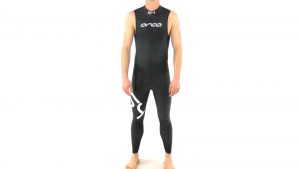Von Collins is an accomplished triathlete and endurance cyclist, and the author of four fitness and training books: Smarter Running, Your First Triathlon Guide, Fit Foods, and 30 Rut-Busting Workouts. He has been cited as a triathlon, cycling, and fitness expert by Healthline, CNET, Forbes, Eat This, Not That and other major outlets.
Swimming in open water, with or without a wetsuit, can be a great experience but should always be done with safety in mind. Swimming safely in open water will give you peace of mind, making your hobby even more enjoyable. During triathlon events, there are usually many lifeguards and safety boats in the water, making the event pretty secure.
Still, water is water, and swimming in open water is something that should be done with a little planning and caution. Swimming in a bunch of weeds, or near motorized boats, can introduce risk that you don’t need to have. Not to mention that if you were to have a dreaded cardiac or other health event in the water, it is not like in running where you can just take a knee and attend to your health. Triathlons tend to be safe events to participate in, but when there is a problem it often comes in the swim leg.
For those who are swimming in open water on their own, practicing for a race or simply doing it for the exercise, there are a few tips to keep in mind to make sure it is a safe experience.
Open Water Swim Practice Tips
Open Swim With A Partner or Group. If possible, swim with another person or people during your open water swims. Having a partner or group not only provides a helping hand should something go wrong, but it also creates a better visual deterrent for boaters or jet-skiers. There are power in numbers, and it is hard to miss a group of 6 or 10 swimming through the water. If you don’t have other triathletes are swimmers to buddy with, then at least consider having a friend kayak or paddle next to you while you get your swim workout in.
Consider Safety Equipment. In addition to providing comfort and speed, a good triathlon wetsuit provides buoyancy that can serve as almost a life jacket if you encounter a problem. In addition to a wetsuit, other items can also help provide some added safety. A pull buoy can create something to hold on to if you have an emergency in the water. And don’t forget about being visible to boaters in the water with a neon swim cap . The other thing you will see some swimmers using is a flag that attaches to your back while swimming, although we admittedly have never tested one so cannot vouch for how they feel and work in the water. These items would not be used on race day, of course, but when it comes to a practice session in a lake or harbor, making yourself visible is a wise idea.
Find Off-Peak Locations and Times. Swimming on weekdays and early in the morning provides much quieter lakes, especially if you are swimming in urban areas. Boaters and jet skiers are often moving across the lake at high speeds, and their eyes are trained to look for other boats, not swimmers. Going for your swims when traffic is lowest reduces the chances of a run-in with a vessel. In many cases, morning swims are going to be quieter with less boat traffic. Just make sure the sun is up — you do not need to add more risk factors to your swim by swimming in the dark.
Beware of Hazards. Not only are boats hazards — the hazards can actually be beneath you in the water. Staying away from weeds and rocks is important for your safety, as getting tangled in them can great an inconvenience and safety issue. Stay in water that is at least 10 feet deep — more in some lakes — to avoid weeds or rocks in the lake. While this is counterintuitive for many who think that swimming in shallow water is safest, most people who swim in lakes or rivers routinely will tell you that they prefer slightly deeper water. When you don’t know the lake or river well, a great thing to do first is to look at a detailed lake map (often made for fishermen) to tell you what depths and obstacles might be in the body of water.

Wear a Wetsuit. Don’t forget about the value of a wetsuit. A good wetsuit will not only keep you warmer in the water, but it will make you a bit more buoyant — enough to feel a difference and be a little more secure. Many triathletes and open water swimmers feel naked without the extra buoyancy of a wetsuit. It is kind of like a safety blanket. The extra flotation can also come in handy
in the event you have a problem in the water. If you don’t have a wetsuit and aren’t sure where to look, start with our primer on wetsuits.
Conclusion
Swimming in open water can provide some of the best, most enjoyable workouts that you will have all year, and being experienced in the open water will make you much more confident when it comes to race day. Just take a few steps to ensure a level of open water swim safety. Much like cycling, a little focus on safety can go a long way and keep you in the game.







